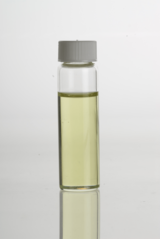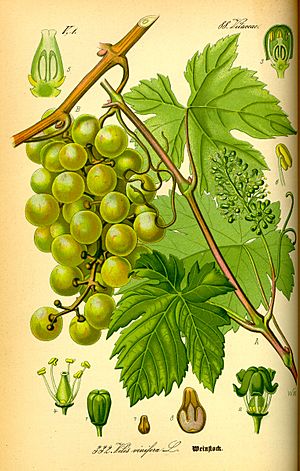Grape seed oil facts for kids

Grape seed oil in clear glass vial
|
|
| Fat composition | |
|---|---|
| Saturated fats | |
| Total saturated | Palmitic: 7% Stearic: 4% |
| Unsaturated fats | |
| Total unsaturated | 86% |
| Monounsaturated | 16.1% |
| Palmitoleic acid | <1% |
| Oleic acid | 15.8% |
| Polyunsaturated | 69.9% |
| Omega-3 fatty acids | α-Linolenic: 0.1% |
| Omega-6 fatty acids | Linoleic: 69.6% |
| Properties | |
| Food energy per 100 g (3.5 oz) | 3,700 kJ (880 kcal) |
| Smoke point | 216 °C (421 °F) |
| Iodine value | 124-143 |
| Saponification value | 126 (NaOH) 180-196 (KOH) |
| Unsaponifiable | 0.3% - 1.6% |
| Peroxide value | 2.92 mequiv/kg |
Grape seed oil (also called grapeseed oil or grape oil) is a vegetable oil derived from the seeds of grapes. A by-product of the winemaking industry, it is typically used for edible applications.
Contents
Uses
Cooking
Grape seed oil has a moderately high smoke point of approximately 216 °C (421 °F). Due to its clean, light taste, and high polyunsaturated fat content, it may be used as an ingredient in salad dressings and mayonnaise and as a base for oil infusions of garlic, rosemary, or other herbs or spices. It is widely used in baked goods, pancakes, and waffles. It is sprayed on raisins to help them retain their flavor.
Research
A study of 21 grape cultivars showed variation of oil composition, especially for linoleic acid and tocopherols.
Although grape seeds contain polyphenols, such as proanthocyanidins, grape seed oil contains negligible amounts of these compounds. Grape seed oil components are under study for their potential applications in human health, but the scientific quality of clinical research as of 2016 has been inadequate to suggest any effect on lowering disease risk.
Possible contamination
Grapeseed oil has occasionally been found to contain dangerous levels of polycyclic aromatic hydrocarbons because of direct contact with combustion gases during the drying process.
Production
Winemaking accounts for 90% of grape cultivation, with the seeds of the plant serving as a by-product that can be pressed for oil. Grapeseed oil production primarily occurs in wine-growing regions, especially around the Mediterranean Sea.
Composition
The following table lists a typical fatty acid composition of grape seed oil:
| Acid | Type | Percentage |
|---|---|---|
| Linoleic acid | ω−6 unsaturated | 69.6% |
| Oleic acid | ω−9 unsaturated | 15.8% |
| Palmitic acid (Hexadecanoic acid) |
Saturated | 7% |
| Stearic acid (Octadecanoic acid) |
Saturated | 4% |
| Alpha-linolenic acid | ω−3 unsaturated | 0.1% |
| Palmitoleic acid (9-Hexadecenoic acid) |
ω−7 unsaturated | less than 1% |
Grape seed oil also contains 0.8 to 1.5% unsaponifiables rich in phenols (tocopherols) and steroids (campesterol, beta-sitosterol, stigmasterol). Grapeseed oil contains small amounts of vitamin E, but safflower oil, cottonseed oil, or rice bran oil contain greater amounts. Grapeseed oil is high in polyunsaturates and low in saturated fat.
Comparison to other vegetable oils
Properties of vegetable oils
| The nutritional values are expressed as percent (%) by mass of total fat. | |||||||||
| Type | Processing treatment |
Saturated fatty acids |
Monounsaturated fatty acids |
Polyunsaturated fatty acids |
Smoke point | ||||
|---|---|---|---|---|---|---|---|---|---|
| Total | Oleic acid (ω-9) |
Total | α-Linolenic acid (ω-3) |
Linoleic acid (ω-6) |
ω-6:3 ratio |
||||
| Avocado | 11.6 | 70.6 | 52–66 | 13.5 | 1 | 12.5 | 12.5:1 | 250 °C (482 °F) | |
| Brazil nut | 24.8 | 32.7 | 31.3 | 42.0 | 0.1 | 41.9 | 419:1 | 208 °C (406 °F) | |
| Canola | 7.4 | 63.3 | 61.8 | 28.1 | 9.1 | 18.6 | 2:1 | 238 °C (460 °F) | |
| Coconut | 82.5 | 6.3 | 6 | 1.7 | 175 °C (347 °F) | ||||
| Corn | 12.9 | 27.6 | 27.3 | 54.7 | 1 | 58 | 58:1 | 232 °C (450 °F) | |
| Cottonseed | 25.9 | 17.8 | 19 | 51.9 | 1 | 54 | 54:1 | 216 °C (420 °F) | |
| Flaxseed/linseed | 9.0 | 18.4 | 18 | 67.8 | 53 | 13 | 0.2:1 | 107 °C (225 °F) | |
| Grape seed | 10.5 | 14.3 | 14.3 | 74.7 | – | 74.7 | very high | 216 °C (421 °F) | |
| Hemp seed | 7.0 | 9.0 | 9.0 | 82.0 | 22.0 | 54.0 | 2.5:1 | 166 °C (330 °F) | |
| Olive | 13.8 | 73.0 | 71.3 | 10.5 | 0.7 | 9.8 | 14:1 | 193 °C (380 °F) | |
| Palm | 49.3 | 37.0 | 40 | 9.3 | 0.2 | 9.1 | 45.5:1 | 235 °C (455 °F) | |
| Peanut | 16.2 | 57.1 | 55.4 | 19.9 | 0.318 | 19.6 | 61.6:1 | 232 °C (450 °F) | |
| Rice bran oil | 25 | 38.4 | 38.4 | 36.6 | 2.2 | 34.4 | 15.6 | 232 °C (450 °F) | |
| High-oleic safflower oil | 7.5 | 75.2 | 75.2 | 12.8 | 0 | 12.8 | very high | 212 °C (414 °F) | |
| Sesame | 14.2 | 39.7 | 39.3 | 41.7 | 0.3 | 41.3 | 138:1 | ||
| Soybean | partially hydrogenated | 14.9 | 43.0 | 42.5 | 37.6 | 2.6 | 34.9 | 13.4:1 | |
| Soybean | 15.6 | 22.8 | 22.6 | 57.7 | 7 | 51 | 7.3:1 | 238 °C (460 °F) | |
| Walnut oil | unrefined | 9.1 | 22.8 | 22.2 | 63.3 | 10.4 | 52.9 | 5:1 | 160 °C (320 °F) |
| Sunflower | 8.99 | 63.4 | 62.9 | 20.7 | 0.16 | 20.5 | 128:1 | 227 °C (440 °F) | |
| Cottonseed | hydrogenated | 93.6 | 1.5 | 0.6 | 0.2 | 0.3 | 1.5:1 | ||
| Palm | hydrogenated | 88.2 | 5.7 | 0 | |||||
See also
 In Spanish: Aceite de pepitas de uva para niños
In Spanish: Aceite de pepitas de uva para niños


